Mostrar el registro sencillo del ítem
dc.contributor.author
Karp, Robert L.
dc.contributor.author
Pérez Millán, Mercedes Soledad

dc.contributor.author
Dasgupta, Tathagata
dc.contributor.author
Dickenstein, Alicia Marcela

dc.contributor.author
Gunawardena, Jeremy
dc.date.available
2019-01-23T14:05:56Z
dc.date.issued
2012-10
dc.identifier.citation
Karp, Robert L.; Pérez Millán, Mercedes Soledad; Dasgupta, Tathagata; Dickenstein, Alicia Marcela; Gunawardena, Jeremy; Complex-linear invariants of biochemical networks; Academic Press Ltd - Elsevier Science Ltd; Journal of Theoretical Biology; 311; 10-2012; 130-138
dc.identifier.issn
0022-5193
dc.identifier.uri
http://hdl.handle.net/11336/68434
dc.description.abstract
The nonlinearities found in molecular networks usually prevent mathematical analysis of network behaviour, which has largely been studied by numerical simulation. This can lead to difficult problems of parameter determination. However, molecular networks give rise, through mass-action kinetics, to polynomial dynamical systems, whose steady states are zeros of a set of polynomial equations. These equations may be analysed by algebraic methods, in which parameters are treated as symbolic expressions whose numerical values do not have to be known in advance. For instance, an "invariant" of a network is a polynomial expression on selected state variables that vanishes in any steady state. Invariants have been found that encode key network properties and that discriminate between different network structures. Although invariants may be calculated by computational algebraic methods, such as Gröbner bases, these become computationally infeasible for biologically realistic networks. Here, we exploit Chemical Reaction Network Theory (CRNT) to develop an efficient procedure for calculating invariants that are linear combinations of "complexes", or the monomials coming from mass action. We show how this procedure can be used in proving earlier results of Horn and Jackson and of Shinar and Feinberg for networks of deficiency at most one. We then apply our method to enzyme bifunctionality, including the bacterial EnvZ/OmpR osmolarity regulator and the mammalian 6-phosphofructo-2-kinase/fructose-2,6-bisphosphatase glycolytic regulator, whose networks have deficiencies up to four. We show that bifunctionality leads to different forms of concentration control that are robust to changes in initial conditions or total amounts. Finally, we outline a systematic procedure for using complex-linear invariants to analyse molecular networks of any deficiency.
dc.format
application/pdf
dc.language.iso
eng
dc.publisher
Academic Press Ltd - Elsevier Science Ltd

dc.rights
info:eu-repo/semantics/openAccess
dc.rights.uri
https://creativecommons.org/licenses/by-nc-nd/2.5/ar/
dc.subject
Bifunctional Enzyme
dc.subject
Chemical Reaction Network Theory
dc.subject
Invariant
dc.subject
Robustness
dc.subject.classification
Matemática Pura

dc.subject.classification
Matemáticas

dc.subject.classification
CIENCIAS NATURALES Y EXACTAS

dc.title
Complex-linear invariants of biochemical networks
dc.type
info:eu-repo/semantics/article
dc.type
info:ar-repo/semantics/artículo
dc.type
info:eu-repo/semantics/publishedVersion
dc.date.updated
2019-01-22T15:12:31Z
dc.journal.volume
311
dc.journal.pagination
130-138
dc.journal.pais
Estados Unidos

dc.description.fil
Fil: Karp, Robert L.. Harvard Medical School; Estados Unidos
dc.description.fil
Fil: Pérez Millán, Mercedes Soledad. Universidad de Buenos Aires. Facultad de Ciencias Exactas y Naturales. Departamento de Matemática; Argentina. Consejo Nacional de Investigaciones Científicas y Técnicas; Argentina
dc.description.fil
Fil: Dasgupta, Tathagata. Harvard Medical School; Estados Unidos
dc.description.fil
Fil: Dickenstein, Alicia Marcela. Consejo Nacional de Investigaciones Científicas y Técnicas. Oficina de Coordinación Administrativa Ciudad Universitaria. Instituto de Investigaciones Matemáticas "Luis A. Santaló". Universidad de Buenos Aires. Facultad de Ciencias Exactas y Naturales. Instituto de Investigaciones Matemáticas "Luis A. Santaló"; Argentina
dc.description.fil
Fil: Gunawardena, Jeremy. Harvard Medical School; Estados Unidos
dc.journal.title
Journal of Theoretical Biology

dc.relation.alternativeid
info:eu-repo/semantics/altIdentifier/doi/http://dx.doi.org/10.1016/j.jtbi.2012.07.004
dc.relation.alternativeid
info:eu-repo/semantics/altIdentifier/url/https://www.sciencedirect.com/science/article/pii/S0022519312003384
Archivos asociados
